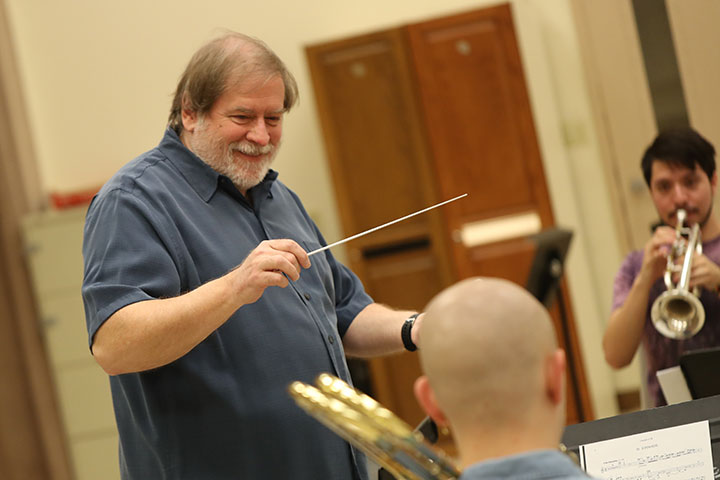Notes, Rhythm, Research: Baylor Professor Creates New Knowledge Through Orchestral Leadership

Contact: Whitney Richter, Director of Marketing and Communications, Office of the Vice Provost for Research, 254-710-7539
Written by: Blake Thomas, Office of the Vice Provost for Research
WACO, Texas (Aug. 1, 2019) - For Stephen Heyde, the Mary Franks Thompson Professor of Orchestral Studies in Baylor’s School of Music and the university’s Conductor-in-Residence, leading a university symphony is about more than just training musicians and presenting high-quality musical performances. It involves elements of history, physiology, and leadership development, culminating in an educational and cultural experience that benefits musicians, audiences and the larger community.
At first glance, it might seem strange to say that a symphony conductor is someone who engages in research. And it’s easy to understand why. Most people see conductors when they are on stage, leading a group of musicians. But to attend a symphony and leave with the idea that conductors “only keep time” during performances is akin to walking into a scientific conference and thinking chemists or physicists “only present posters” on their chosen topics.
Indeed, just as the bulk of a laboratory scientist’s effort happens long before the results of the work are made public, some of a conductor’s most challenging work happens off-stage, months and even years prior to a symphony’s first note. Conductors are responsible for countless choices that impact the orchestra’s performance, from selection of repertoire and interpretation of the pieces to matters as subtle as how the musicians are arranged on the stage. Every decision along the way has an impact on how the audience will hear the final performance, so the choices are not taken lightly.
“A college orchestra is a capstone experience much like working in a laboratory,” Heyde says. “Musicians assimilate all their knowledge and skills they’ve developed before in their small ensembles and private lessons.”
The work of developing a university orchestra begins with choosing the individuals who make up the orchestra through auditions. But unlike in a professional symphony, the conductor of a university orchestra is not looking for just the top musicians.
“The educational perspective changes the formula,” Heyde explains. “We don’t expect first-year students to be at the level of graduate students, so we seek balance and look for students who have the capacity to contribute.”
Having selected the orchestra’s members, Heyde turns his attention to choosing a repertoire that will showcase the talents of the musicians while still providing opportunities for growth. Combining music from different eras in different styles that showcase different musicians allows the conductor to communicate with his student musicians about history and culture in a way that no single piece of music could on its own.
Heyde believes strongly in the power of music to communicate across languages and cultures. He points to Shostakovich’s Symphony No. 7, composed during the 900-day siege of Leningrad by Nazi forces during WWII, as one powerful example. The piece had its debut in Leningrad, performed by the few musicians who remained in the city, and the score was smuggled out and became a rallying cry for the Allied forces.
“The hopelessness of the people in Leningrad was overcome by that symphony,” Heyde says. “The music lit a fire and strengthened the desire to resist. Pieces like that allow audiences to be nourished in the essence of what it was like to be human in another time and place.”
Along with generating new knowledge and creating works that enhance the human experience, one of the most important jobs of any academic is education. For Heyde, training the next generation of musicians and scholars goes hand-in-hand with his own professional development. The list of Heyde’s former students includes successful musicians in virtually every genre, as well as 12 individuals who have gone on to become professional conductors.
Beverly Everett says it was Heyde’s influence and encouragement that helped her decide to pursue conducting. Everett, who is now conductor and music director of both the Bismarck-Mandan Symphony Orchestra and the Bemidji Symphony Orchestra, entered college at Baylor as an organ major, intending to study under the university’s organist in residence, Dr. Joyce Jones. She met Heyde for the first time when she took a conducting class as part of the required coursework for her major. By her junior year, she had made the decision to pursue conducting as a career.
Everett, who received both her bachelor’s degree in 1992 and a master’s in conducting in 1996 at Baylor, says Heyde’s practical advice and encouragement provided her with inspiration that she still relies on daily.
“He showed me the dedication that it takes to be a conductor,” she recalls, “and he encouraged me to make sure that every day I do something toward the goal of making music.”